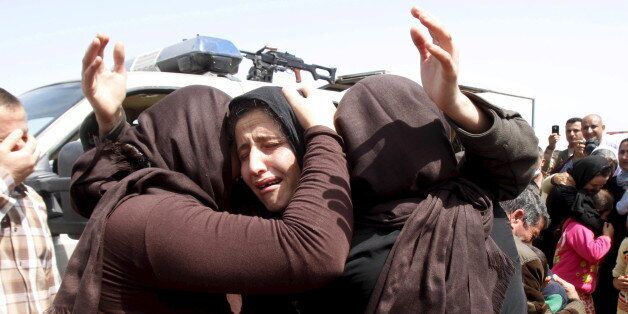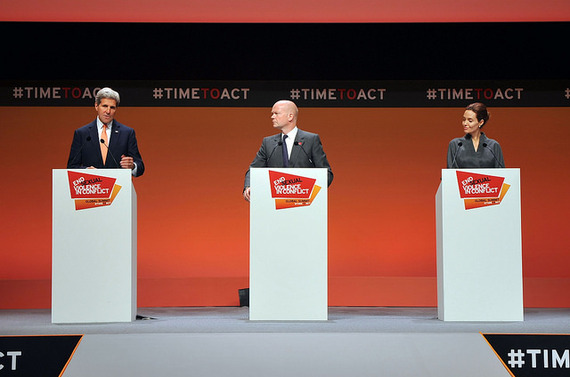
U.S. Secretary of State John Kerry addresses reporters during news conference with British Foreign Secretary William Hague and actress and UN Envoy Angelina Jolie at the conclusion of the 2014 Global Summit to End Sexual Violence in Conflict in London on June 13, 2014. [State Department photo]Last week, the UN Commission of Inquiry for Syria found that ISIL is committing genocide against the Yezidis, echoing Secretary Kerry's statement from earlier this year. The Commission's report documents the vile and systematic ways in which ISIL sorted, enslaved, and murdered Yezidi women and girls.
How appropriate, then, that today the international community marks the very first International Day to Eliminate Sexual Violence in Conflict. These two events remind us of the critical efforts before us -- supporting survivors and preventing this kind of violence from happening in the first place.
Sexual violence can be used strategically in conflict or in crises to achieve specific ends. It's used to punish and terrorize populations, and destroy communities by tearing the fabric that holds them together. In some cases, it sends a signal about a group's power, or rewards fighters, or even serves to build relationships among combatants.
If this form of violence can be used strategically toward a specific end, then is it also controllable? If it can be turned on, can it also be turned off? Are there common precursors? Understanding this issue requires us to challenge some conventional wisdom around the issue.
We need to challenge the assumption that systematic sexual violence will always happen in war. While the chance of gender-based violence rises in crisis settings as rule of law erodes or social unity dissolves, we've seen conflicts that feature little to no sexual violence as a tactic of conflict -- the Israeli-Palestinian conflict is one of several examples.
We need to challenge the stereotypes around sexual violence in conflict. When we think of survivors, we think of women and girls. But boys and men are also vulnerable, especially in prison or detention settings -- which can perpetuate conflict and exacerbate insecurity across the board. That's why the U.S. Strategy to Prevent and Respond to Gender-based Violence includes these groups as well.
Many people picture this issue in particular places -- most notably in Africa. But research has shown this isn't necessarily the case. One study examined almost 200 different armed actors in 20 African countries and found that the majority had no known record of sexual violence.
We need to challenge the belief that such crimes can be committed with impunity. This means working to hold accountable perpetrators of sexual violence -- calling on countries to investigate and prosecute these crimes in their domestic jurisdictions, and, where needed and requested, finding ways to deliver help build capacity in areas such as forensics, evidence collection, and case-building.
Finally, we need to challenge the idea that sexual violence in conflict is solely an issue for the gender or justice community to work on. Research shows that places with high rates of gender inequality are more likely to experience conflict -- a point President Obama made at the United State of Women earlier this month.
"As Commander-in-Chief, I've seen how the ideology that leads Boko Haram to kidnap schoolgirls, and leads ISIL to enslave and rape women is the same ideology that leads to instability, and violence, and terrorism," he said. "There's a connection there."
By exploring that connection, challenging our assumptions, and broadening the conversation, we can gain a better understanding of this issue -- and put preventative measures in place.
This issue needs experts and leaders across fields working together -- whether your focus is atrocity and conflict prevention, humanitarian aid, programming, peace and reconciliation, justice and accountability, or gender equality.
Today, we renew the call for all of us working in these areas to join our efforts. Learn more about this issue. Broaden your research. Question the assumptions and conventional wisdom. And commit to not only responding to sexual violence in conflict, but preventing it from happening in the first place.

